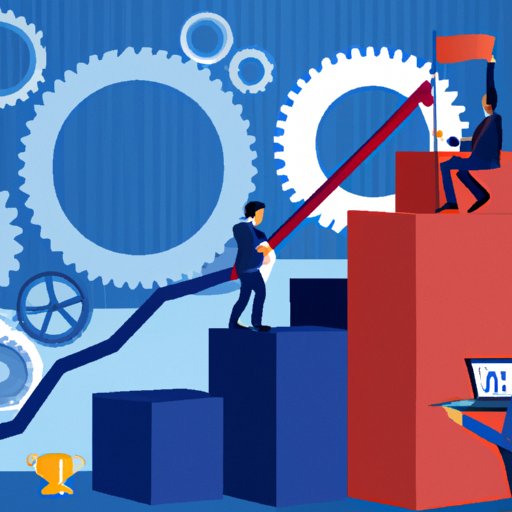How Middle Management Drives Productivity And Improves Employee Engagement

Table of Contents
The Role of Middle Management in Fostering a Productive Workplace
Middle management acts as the bridge between executive leadership and the frontline workforce. Their effectiveness directly influences the productivity and efficiency of entire teams. This section explores key aspects of a productive middle management role.
Effective Communication and Feedback
Clear and consistent communication is paramount. Middle managers must establish clear communication channels and utilize various methods to ensure information reaches everyone.
- Regular Team Meetings: Schedule regular meetings to discuss progress, address challenges, and share updates.
- One-on-One Check-ins: Individual check-ins allow for personalized feedback and address individual employee needs.
- Utilizing Diverse Methods: Employ emails, instant messaging, project management software, and even informal conversations to reach every team member effectively.
- Constructive Feedback: Regular, specific, and actionable feedback is crucial for improvement. Focus on both strengths and areas for development. Celebrate successes!
Employing these strategies helps build trust and transparency, vital for a high-performing team.
Goal Setting and Performance Management
Setting SMART goals is fundamental to productivity. Middle managers play a vital role in guiding their teams toward achieving organizational objectives.
- SMART Goals: Ensure goals are Specific, Measurable, Achievable, Relevant, and Time-bound.
- Performance Management Systems: Implement systems to track progress, identify roadblocks, and provide timely support. Regular performance reviews are key.
- Resource Allocation: Provide the necessary resources, tools, and training to enable employees to succeed.
- Data-Driven Adjustments: Regularly review performance data to identify areas needing improvement and adjust strategies accordingly.
Delegation and Empowerment
Effective delegation is not just about assigning tasks; it's about empowering employees.
- Skill-Based Delegation: Assign tasks based on individual skills and capabilities.
- Empowerment Through Autonomy: Grant employees the authority to make decisions within their scope of responsibility.
- Accountability and Trust: Maintain accountability while fostering trust and encouraging initiative.
- Boosting Morale: Delegation and empowerment boost morale and create a sense of ownership, leading to increased productivity.
Middle Management's Influence on Employee Engagement
Highly engaged employees are more productive, creative, and committed. Middle managers significantly influence this engagement.
Building a Positive Work Environment
Middle managers shape the team's daily experience.
- Recognition and Appreciation: Regularly acknowledge and celebrate employee contributions, both big and small.
- Teamwork and Collaboration: Foster a collaborative environment where employees feel valued and supported.
- Addressing Concerns: Be approachable and responsive to employee concerns, providing necessary support.
- Professional Development: Invest in employee growth by providing training, mentorship, and opportunities for advancement.
- Inclusive Environment: Create a workplace where every employee feels respected and valued, regardless of background or identity.
Mentorship and Professional Development
Middle managers are often the first point of contact for career guidance.
- Mentoring: Provide guidance, support, and advice to help employees develop their skills and advance their careers.
- Training and Skill Development: Offer opportunities for training and skill development to enhance employee capabilities.
- Career Progression: Support career progression within the organization, providing opportunities for growth and advancement.
- Rewarding Achievements: Recognize and reward employee achievements to foster motivation and engagement.
Addressing Employee Concerns and Conflict Resolution
Effective conflict resolution is a critical skill for middle managers.
- Open Communication: Encourage open and honest communication to prevent misunderstandings and address concerns promptly.
- Fair and Transparent Processes: Implement fair and transparent processes for handling complaints and resolving conflicts.
- Conflict Resolution Training: Invest in conflict resolution training for middle managers to equip them with the necessary skills.
- Mediation: Act as mediators when conflicts arise, facilitating constructive dialogue and solutions.
Strategies for Middle Managers to Enhance Productivity and Engagement
Middle managers can actively implement strategies to improve both productivity and employee engagement.
Leading by Example
Middle managers set the tone for their teams.
- Strong Work Ethic: Demonstrate a strong work ethic and commitment to achieving team goals.
- Embracing Company Values: Actively embody and promote the organization's values and culture.
- Positive Attitude: Maintain a positive and supportive attitude, creating a motivating environment.
Utilizing Technology and Tools
Leveraging technology enhances efficiency and collaboration.
- Project Management Software: Implement project management tools to track progress, manage tasks, and improve team coordination.
- Communication Tools: Utilize communication platforms to facilitate collaboration and information sharing.
- Data Analytics: Use data analytics to monitor performance, identify trends, and make data-driven decisions.
Continuous Improvement and Learning
Continuous learning is essential for effective middle management.
- Seeking Feedback: Actively solicit and incorporate feedback from employees and supervisors.
- Professional Development: Engage in ongoing training and development to stay updated on best practices.
- Industry Best Practices: Stay informed about industry trends and best practices in middle management.
Conclusion
Effective middle management is not merely a position; it's a crucial driver of productivity and employee engagement. By fostering open communication, empowering employees through delegation, providing mentorship and development opportunities, and building a positive work environment, middle managers can significantly impact the success of their teams and the organization as a whole. Invest in your middle management team today. By implementing these effective middle management strategies, you can transform your workplace culture, leading to increased productivity and significantly improved employee engagement. Focus on building strong, engaged teams through effective middle management practices and watch your organization thrive.

Featured Posts
-
 Louisville Mail Delays Union Leader Announces End In Sight
Apr 30, 2025
Louisville Mail Delays Union Leader Announces End In Sight
Apr 30, 2025 -
 El Futbol Argentino Llora La Muerte De Una Joven Promesa De Afa
Apr 30, 2025
El Futbol Argentino Llora La Muerte De Una Joven Promesa De Afa
Apr 30, 2025 -
 5 Excellent Cruise Lines For A Family Vacation
Apr 30, 2025
5 Excellent Cruise Lines For A Family Vacation
Apr 30, 2025 -
 Il Complotto Becciu Cosa Rivelano Le Chat Pubblicate Da Domani
Apr 30, 2025
Il Complotto Becciu Cosa Rivelano Le Chat Pubblicate Da Domani
Apr 30, 2025 -
 Time Gala Argamani Calls For Return Of Israeli Hostages
Apr 30, 2025
Time Gala Argamani Calls For Return Of Israeli Hostages
Apr 30, 2025
